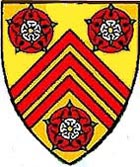
Cymru / Wales
Bro-Gembre

Glamorgan
Morgannwg
| Noms de lieux | Noms de personnes |

Cymru / Wales Bro-Gembre |
blason ou logo en attente | 
Glamorgan Morgannwg |
Cowbridge *** Y Bont Faen
Bovium
| page ouverte le 11.01.2007 | forum de discussion
* forum du site Marikavel : Academia Celtica |
dernière mise à jour 31/12/2008 11:36:26 |
![]()
|
Définition : ville du Pays de Galles; comté de Glamorgan / Morgannwg; |
|
![]()
|
i
extrait de Ordnance Survey : Map of Roman Britain. Localisation au cercle rouge à l'ouest de Cardiff |
![]()
|
Histoire |
![]()
|
Étymologie. A. Bovium. * Rivet & Smith (1979) : SOURCES. - AI 4843 (Iter XII) : BOMIO. - Inscription : In JRS, LVI (1966), 220, there are published two moulded bricks wiith letters in relief by a die reading BOV. They were found at Whitton Cross-roads, St Lythans, Glamorgan, on a site (eventually of a villa) whose occupation lasted from before the Conquest until late in the fourth century. The bricks may have served as tallies. 'BOV may indicate thc name of the local settlement, for which AI gives the form BOMIVM, perhaps to be amended to BOVIVM.' DERIVATION. Bomium can hardly be retained; Jackson in studying the names of AI simply puts a query against it. As is further noted in JRS (above), the emendation to Bovio is easy, and obvious in view of the British precedent Bovium (2) whose name is not in doubt. There may, however, have been some local variation whose reason escapes us but which is paralleled in the m / v alternation in the name of the Gaulish deity Bormo or Borvo, god of hot springs, best known from the site in Gallia Lugdunensis which shows both spellings on its inscriptions : Borvoni et Damonae / Bermoni et Damonae (dat.). The form with b or v eventually triumphed, > Bourbon-Lancy; see Whatmough DAG 598. This variation is not connected with genuine lenition of m > m > v in Britain, which is dated by Jackson to the later part of the fifth century. The two Glamorgan bricks with BOV, and what is said about them in JRS, provide convincing arguments for a Glamorgan Bovium. This, as Jackson says of Bovium (2) in discussing AI, looks like a derivative of British *bou- 'cow', with the common *io- suffix; perhaps 'cow-place'. There are many Bov- names on the Continent, most no doubt from Latin bos bovem; Holder I. 499 has a few forms from Gaul which are probably of Celtic origin. IDENTIFICATION. Probably the Roman settlement at Cowbridge, Glamorgan (SS 9974), 5 1/2 miles from the villa at Whitton Cross-roads (ST 081713). -------------- B. Cowbridge : * Eilert Ekwall, traitant d'un autre Cowbridge en Essex, répond tout simplement : s'explique de lui-même. Il s'agit donc d'un passage de troupeaux de bovins. On pourrait comparer avec Oxford. |
![]()
|
Sources : * Ordnance Survey : Map of Roman Britain. 1956. * A.L.F RIVET & Colin SMITH : The Place-Names of Roman Britain. Batsford Ltd. london. 1979-1982. - John Bartholomew & Son Ltd : Half Inch Map series. South Wales. N° 12. 1971. - Elwyn Davies : Rhestr o Enwau Lleoedd / A Gazetteer of Welsh Place-Names. Gwasg Prifysgol Cymru. Caerdydd. / University of Wales Press. Cardiff. 1975. - Wales Tourist Board : South Wales. 1976. |
![]()
|
Liens électroniques des sites Internet traitant de Cowbridge / Y Bont Faen / Bovium : * lien communal : * autres liens : http://www.britannica.com/EBchecked/topic/141256/Cowbridge * autres propositions de localisation : - Tilton, en Cheshire : http://www.roman-britain.org/places/bovium.htm http://links.jstor.org/sici?sici=0068-113X%281984%2915%3C255%3ATLOB%3E2.0.CO%3B2-J&size=LARGE forum de discussion* forum du site Marikavel : Academia Celtica hast buan, ma mignonig go fast, my little friend |
![]()